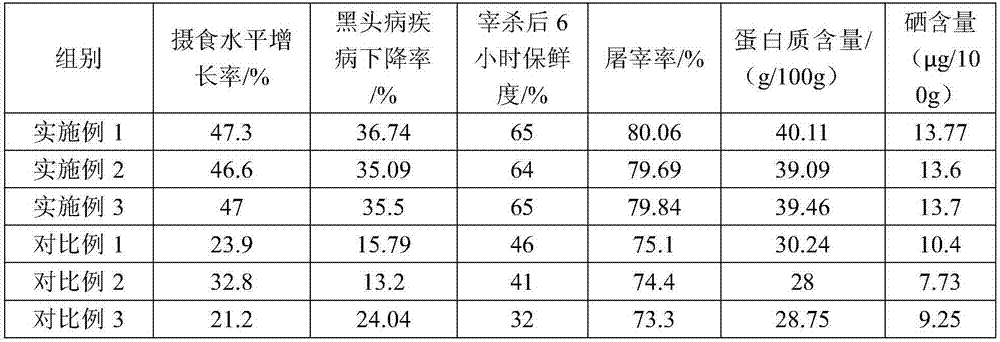Cultivation method for improving peacock growth performance
A technology of growth performance and breeding method, which is applied in the field of breeding to improve the growth performance of peacocks, can solve the problems of animal body poisoning, low bioavailability, and small safety range, and can prevent oxidative necrosis, increase daily weight gain, and improve digestibility. Effect
- Summary
- Abstract
- Description
- Claims
- Application Information
AI Technical Summary
Problems solved by technology
Method used
Image
Examples
Embodiment 1
[0027] A breeding method for improving peacock growth performance, mainly comprising the following steps:
[0028] (1) The chicks drink water 24 hours after hatching, the water temperature is 23°C, and then drops by 1°C every day, and 1.5% glucose and antibiotics are added to the water;
[0029] (2) Brooding period: 1 to 3 months old, 46 parts of selenium-added basic diet, 10 parts of compound Chinese medicine feed additive, and 32 parts of growth supplement feed additive were mixed and fed, fed 3 times a day, a total of 85 g;
[0030] (3) Growth period: 2 to 8 months old, 57.5 parts of selenium-added basic diet, 13.5 parts of compound Chinese medicine feed additive, and 19 parts of growth supplement feed additive were mixed and fed, fed 3 times a day, a total of 225 g;
[0031] (4) Adulthood: 8 to 20 months old, feed 55 parts of selenium-added basic diet, 17.5 parts of compound Chinese medicine feed additive, and 17.5 parts of growth supplement feed additive, twice a day, 265...
Embodiment 2
[0038] A breeding method for improving peacock growth performance, mainly comprising the following steps:
[0039] (1) The chicks drink water 24 hours after hatching, the water temperature is 22°C, and then drops by 1°C every day, and 1% glucose and antibiotics are added to the water;
[0040] (2) Brooding period: 1-3 months old, 40 parts of selenium-added basic rations, 8 parts of compound Chinese medicine feed additives, and 28 parts of growth supplement feed additives were mixed and fed, fed 3 times a day, a total of 50 g;
[0041] (3) Growth period: 2 to 8 months old, 50 parts of selenium-added basic diet, 12 parts of compound Chinese medicine feed additive, and 18 parts of growth supplement feed additive were mixed and fed, and fed 3 times a day, a total of 200 g;
[0042] (4) Adulthood: 8 to 20 months old, feed 50 parts of selenium-added basic diet, 15 parts of compound Chinese medicine feed additive, and 15 parts of growth supplement feed additive, twice a day, 250 g in...
Embodiment 3
[0049] A breeding method for improving peacock growth performance, mainly comprising the following steps:
[0050] (1) The chicks drink water 24 hours after hatching, the water temperature is 24°C, and then drops by 1°C every day, and 2% glucose and antibiotics are added to the water;
[0051] (2) Brooding period: 1-3 months old, 52 parts of selenium-added basic rations, 12 parts of compound Chinese medicine feed additives, and 36 parts of growth supplement feed additives were mixed and fed, and fed 4 times a day, a total of 120g;
[0052] (3) Growth period: 2 to 8 months old, feed 65 parts of selenium-added basic diet, 15 parts of compound Chinese medicine feed additive, and 20 parts of growth supplement feed additive, and feed 3 times a day, a total of 250 g;
[0053] (4) Adulthood: 8 to 20 months old, feed 60 parts of selenium-added basic diet, 20 parts of compound traditional Chinese medicine feed additive, and 20 parts of growth supplement feed additive, and feed 3 times ...
PUM
 Login to View More
Login to View More Abstract
Description
Claims
Application Information
 Login to View More
Login to View More - R&D
- Intellectual Property
- Life Sciences
- Materials
- Tech Scout
- Unparalleled Data Quality
- Higher Quality Content
- 60% Fewer Hallucinations
Browse by: Latest US Patents, China's latest patents, Technical Efficacy Thesaurus, Application Domain, Technology Topic, Popular Technical Reports.
© 2025 PatSnap. All rights reserved.Legal|Privacy policy|Modern Slavery Act Transparency Statement|Sitemap|About US| Contact US: help@patsnap.com

